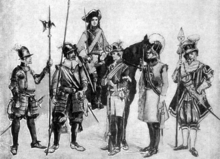Trabant (military)
Trabants ( late mhd .: Drabant ) were, especially in the late Middle Ages and the early modern period, companions or bodyguards on foot. They served partly as a guard for princely persons, high officials and the Landsknecht colonels , partly as executors of their orders. For a long time it was the custom to dress her in short, wide trousers and a doublet , in the Spanish fashion. The armament was initially halberds and the thrusting sword . Later they were also used as cavalrymen.
The satellite guards often formed the tribe of the house troops or, as in Brandenburg , of the field troops. The Gardes du Corps emerged in 1692 from the two Trabanten companies of the Great Elector of Brandenburg , who fought at Fehrbellin in 1675 .
In the then newly created Electoral Saxon Army , the ranking of 1682 names 172 horses in the life guard on horseback as well as 65 men in the foot guard . In 1701 the Saxon satellites became the Saxon Guard du Corps . This Saxon regiment came to an end in Napoleon's Russian campaign in 1812/13 . In the endless march on Moscow and in the subsequent march back, almost all the satellites were killed. The Saxon king no longer reorganized this guard regiment.
Trabanten was also the name of the 150-man elite troop and bodyguard of Charles XII , equipped with special privileges . in the Great Northern War.
Web links
literature
- Johannes Anton Larraß : History of the Royal Saxon 6th Infantry Regiment No. 105 and its prehistory 1701 to 1887. Print: HL Kayser, Strasbourg i. E., 1887.
- Saxony's military club calendar, born in 1915 , Der Kamerad printing house , published by FL Staub, Dresden (1914)

